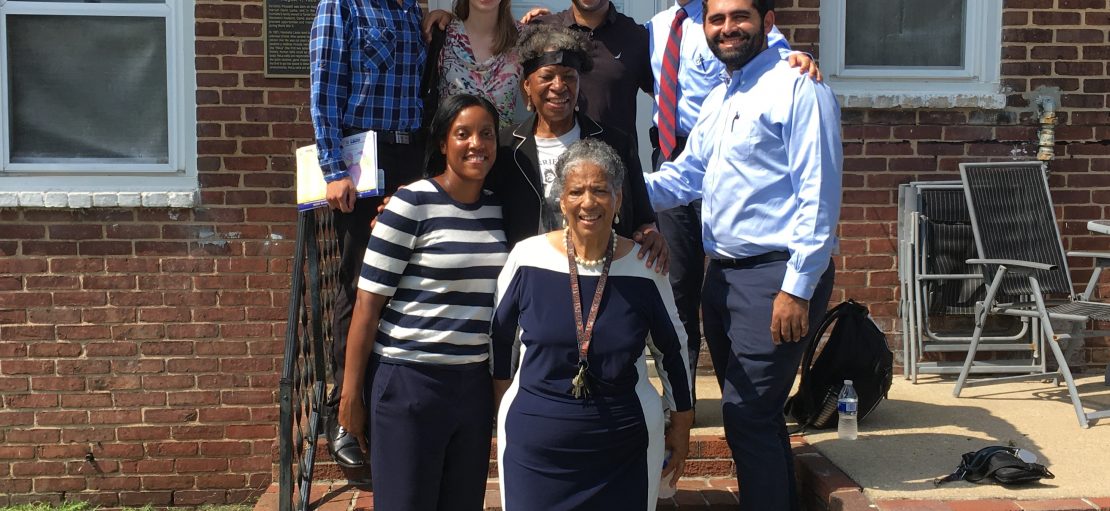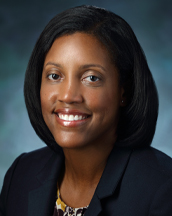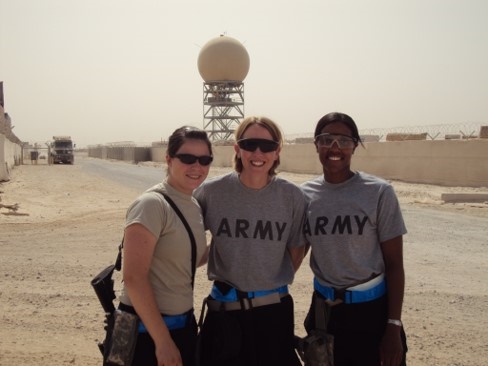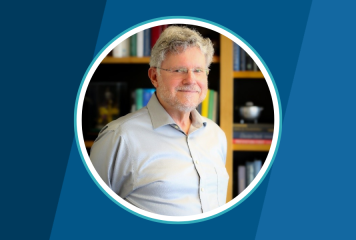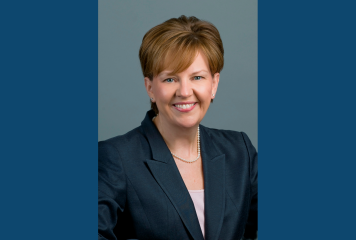Erica N. Johnson has been named the new chair of ABIM’s Infectious Disease Board, with her term beginning on April 1. She is an Assistant Professor of Medicine in the Division of Infectious Diseases at Johns Hopkins University School of Medicine and the Program Director for the Internal Medicine Residency at Johns Hopkins Bayview Medical Center. She is board certified in Internal Medicine and Infectious Disease and is also a fellow of the American College of Physicians (ACP) and the Infectious Diseases Society of America (IDSA).
In 2014, Dr. Johnson completed an 11-year career in the U.S. Army Medical Corps, where she served as the Associate Program Director for the Internal Medicine Residency and Infectious Disease Fellowship Programs in the San Antonio Uniformed Services Health Education Consortium. She also served as a clinical investigator with the Infectious Disease Clinical Research Program. She has won several awards for her work increasing the diversity of residents at Johns Hopkins Bayview Medical Center and the programs she facilitates in the Turner Station community in Baltimore.
Congratulations on being named the new chair of the ABIM Infectious Disease Board. What are some of the goals you would like to accomplish in your new position?
Thank you. I think that one of the things that would be really important to me is ensuring that we’re really listening to diplomates, and making sure that we are representative of the diverse perspectives of all the different infectious disease ABIM diplomates. And then also fulfilling that sense of duty to the community. I think that there are a lot of reasons historically for mistrust between communities and institutions of science and medicine, and I think that the pandemic has certainly taught us the consequences of that. There are severe health consequences related to structural barriers and to that sense of mistrust. And so, I think what’s necessary is as much transparency as possible.
And I hope that through my role on the Specialty Board, I can help foster a group of physicians who will listen to patients’ stories, and share those stories with institutions and organizations that have the power to elevate them in ways that can help us think about how we might reduce some of these structural forces in medicine that are impacting the health and well-being of our patients and our communities.
Have you seen a lot of these structural barriers with the different communities you work with and COVID? I know you work with the Turner Station community in Baltimore. Can you tell us a little bit about that?
I think one of the really rich things about my job is that I work in Baltimore, and I’m from Baltimore. And having grown up here and seeing how communities interact with the large healthcare systems here within Maryland, including Hopkins, I’ve been able to witness some of the impact that these structural forces have on health. So, one of the things that I do in my role as an educator with all of my trainees—with all my residents and students that I work with—is try to really emphasize how important historical context is to their training, to the development of their professional identify as physicians.
A lot of the community engagement work that we do is completely reciprocal. We hope to be of help to the community, but I’m also hoping that the voices and the perspectives of the community will help shape my learners, and will help them get a real feeling for Baltimore and its communities. The work in Turner Station really grew out of that. Turner Station is the historical home of Henrietta Lacks, and Henrietta Lacks’s story is an important one to tell because it is directly related to how medical institutions exploited Blacks and other marginalized persons throughout history.
This is a story that is really relevant to Hopkins. This happened right here at Hopkins; this happened right here in Baltimore. And through the relationship with Turner Station, by ensuring that my new interns here at the John Hopkins Bayview Internal Medicine Residency Program understand that story, understand her legacy, understand how that history of exploitation impacted her family and continues to generations later, I think all of that adds some really deep meaning. I think they recognize what a privilege it is to be a doctor today, but they also recognize the urgent challenges that face them as they think about what type of doctor they want to be and what their role will be in medicine.
Can you tell us a little bit more about how the Turner Station program works?
Our partnership with Turner Station builds on some existing collaborations that started even before I came to Hopkins, largely collaborations between faith communities in Baltimore, including in Turner Station, and our hospital, Hopkins Bayview. When I first came to Hopkins Bayview, I was introduced to some of the elders in Turner Station by faculty members as part of work we were doing in a course called Foundations of Clinical Excellence, which is an introductory course that we have for all of our interns.
Our community partners in Turner Station were very interested in something that would help support youth in Turner Station, help give them some more exposure to Hopkins and to some of the young doctors in training at Hopkins. And it was out of this collaboration that the idea for Project Voice was born. Project Voice used a community-based participatory research tool called Photo Voice, which trains people to use photography to tell stories. And it’s a great way to break down any types of barriers to storytelling, because photos are such an important part of how we share our experiences.
The way the collaboration worked is we hired a photography student from one of the local Historically Black Colleges and Universities, Morgan State University here in Baltimore, who trained Girl Scouts from a troop in Turner Station in some basic photography skills with point and shoot cameras. Then, they interviewed and spent some time with elders in the community. They heard their stories of what they thought about living in Turner Station, what their daily life was like, what their perspectives on health and on aging were in that community. And then our resident physicians worked with the girls and with the elders to help provide some platforms for sharing these stories.
We would host these rich Saturday morning discussions where the elders, the Girl Scouts, our resident physicians and all of our faculty collaborators would get together and share the pictures and the stories associated with them, and then talk about real issues that members of the community faced. These discussions included what they wanted from their healthcare system and what the experience was like as they aged in a community that had changed pretty dramatically over the decades because of a history of underinvestment in historically Black neighborhoods here in Baltimore.
It was just this wonderful and amazing experience, and I think everyone really learned a lot from each other. It’s an experience we hope to replicate in some other types of health community collaborations going forward.
How have you been reaching out to these communities during a time of COVID?
We have some other community-based partnerships through an initiative at Hopkins Bayview called Medicine for the Greater Good. Medicine for the Greater Good started as a way to teach residents about social determinants of health and their impact on the health of our communities, but also a way to teach them some basic skills in community-oriented practice. We work in collaboration with various community organizations. One of our Medicine for the Greater Good programs is a lay health educator program where resident physicians teach community leaders about various health topics and the community leaders then go back and teach their organizations or their constituents or their congregations about it.
Because of the need for physical distancing and avoiding large gatherings, we’ve been taking a lot of these teaching sessions onto Zoom or other platforms and even doing conference calls. Later this morning, actually, I have a conference call with community leaders as part of a weekly call where we just provide updates about COVID, and lately we’ve been talking a lot about the vaccines and variants and other things that are on people’s minds right now.
I think the Zoom and conference calls have actually helped us to reach a broader audience, because it takes away the requirement of being on campus at a certain time. And so, we’ve had a broader reach. I think that even after the pandemic, when we’re able to get together in gathering spaces again, we’ll probably still continue using some of the online tools and the phone calls as well as the in-person visits.
There have been a lot of discussions lately about how we can we bring more vaccines to communities of color, and whether there is a real hesitancy for individuals in those communities to get the vaccine. Is there anything you’re working toward on that end?
Yes, we talk a lot in these community sessions about hesitancy, and there certainly is an issue related to hesitancy, and some of what we talk about is how to work around that. One of the great ways to work around that, I think, is by having credible community leaders talking about the vaccine and providing information, but also eliciting the perspectives of the people they’re talking to and trying to find out their reasons for the hesitancy. There are as many different reasons people might be hesitating on the vaccine as there are individuals. So, I’m really trying to understand everyone’s different perspective.
But the other thing that is going on in my state of Maryland is that, structurally, the way that we’ve done the vaccine rollout has had a differential impact on communities of color. Specifically, I think some of the ways in which the vaccine has been distributed have made it harder for some communities to access the vaccine.
So, while hesitancy is a big part of the story, I think what we’re really trying to do here within the state is work through some of these structural factors and make sure that vaccines are going to the places that are close to communities that we know have fewer transportation options to get to some of these larger vaccine sites. We also need to make sure that they are not counting large numbers of the vaccine that have been distributed to major healthcare centers against certain zip codes. Even though certain medical centers and health systems have gotten a lot of the vaccine, that doesn’t mean that all of those doses are getting to people in the zip codes immediately adjacent to where these hospitals are located–at least, not in the same way that a large distribution going to retail pharmacies, for example, in a different zip code would.
I think working out some of those things that are not intentional but have led to some barriers to some people getting the vaccine are also an important side of the story.
What are the most important things people need to know about COVID-19?
I think that the most important message is just how critical basic public health measures are to control the spread of the virus. And even as we are getting more and more people vaccinated, I think it’s really important not to let our guards down on the basic public health measures of wearing our masks, washing our hands and avoiding large gatherings. And honestly, I hope that people know that this is going to continue to be a reality for months now, even as we continue vaccine uptake. And, don’t lose hope—ultimately, we’ll get through this, but it’s just going to take a little bit more time.
Tell us about how you’ve worked to diversify the residency program at Hopkins Bayview.
I think we’ve been really intentional about thinking about the ways in which unconscious bias could be involved in the process of selecting interns, and then trying to be really intentional about reducing that bias. We recognized a few years ago that there is a problem. We saw that the percentage of underrepresented-in-medicine matriculants starting in our internship program was declining for three consecutive years, and suspected, based on some reading in the literature, that this could be related to elements of unconscious bias in our processes.
We set out to make sure that our residency selection team had all been appropriately educated on the roles of unconscious bias, took implicit association tests, talked together as a team about recognizing our own biases and trying to mitigate the impact of those biases. Then, we also looked at the process that we use to go through applications and tried to make it as holistic a review as possible. We ensured that we were reading all parts of the application. We removed any sorts of screening processes that would have us not looking at certain applications. And then we also applied the AAMC’s Experiences-Attributes-Metrics model as we were thinking about how to go through and score these applications.
We really tried to prioritize some of the experiences and attributes related to a particular applicant’s candidacy over maybe some of the objective metrics that we know can have some inherent bias associated with them. I’m thinking of things like clerkship grades and standardized test scores and things like that, that have some bias associated with those particular types of metrics.
In doing those things, we were able to dramatically change not just the percentage of underrepresented in medicine candidates that we were interviewing and discussing and ranking, but also, we saw marked improvements for three consecutive years in the percentages of matriculants to our program who were underrepresented in medicine. It’s something that we’ve continued throughout and is an important part of how we think about recruiting to our residency program.
We also see it as core to our mission. The mission of our program is very much related to doing the important work at the intersection of health and justice. And part of that, I think, is ensuring that the workforce is representative of the communities that we’re taking care of. It’s important for us to have a diverse class of trainees to do that.
Is it true that the number of unrepresented in medicine went from 9 percent in 2017 to 41 percent in 2018?
That’s correct.
It seems like this can be a blueprint for success; are you sharing how you’ve done this with others?
We’ve been able to share it in some presentations, and here within Hopkins the different residency fellowship program directors have also heard that message from me. I’ve done some presentations amongst our group here as well. We were able to win a national award through the Alpha Omega Alpha Honor Medical Society related to the work that we had done, and I’m working on a paper.
How would you say increasing the number of underrepresented-in-medicine residents has changed how things work there?
Everything about our program has gotten better, honestly. There have been some objective metrics that have improved, including things like ABIM certifying exam pass rates, which have been consistently 100 percent, and that is a hard thing to do for a program of our size. We’re really proud that. We have had really great success in fellowship matches, including having more candidates stay here at Hopkins, which is an important institutional metric. Hopkins is trying to keep more of its residents, in recruiting them into their fellowships and recruiting them onto faculty positions here. We’ve had more people stay at Hopkins since we’ve made these changes within the program.
We’ve had increases in our rates of residents having peer reviewed manuscripts accepted for publication and abstracts presented at meetings. We’ve had residents sitting on national committees. Everything seems to have gotten better in the past few years. And I think that’s because of what we’ve been able to do in the program around diversity.
Do you feel like it’s affected the community in your area as well?
I think so. I think we’re bringing residents to the program who are recognizing that part of our core mission is that piece of community engagement and doing the work at the intersection of health and justice. They’re coming here wanting to do that. They’re coming wanting to be in Baltimore and to work in Baltimore. So, we’re seeing increased participation in our Medicine for the Greater Good initiative.
You spent 11 years in the US Army Medical Corps, earning a bronze star before joining the faculty of Johns Hopkins Bayview Medical Center. Why did you decide to join the military and the medical corps, and how has it influenced you?
I decided to join because I knew that I wanted to be a doctor, but I didn’t exactly know what that meant or what sort of doctor that I wanted to be. I saw the military as a way to try different things, sometimes even all at the same time, and I figured that, ultimately, I would figure it out. I also think I had a little bit of wanderlust. I wanted to see some things outside of Baltimore. I saw the military as an opportunity to be able to travel the world and get some experiences that I just didn’t think would have been possible otherwise, based on my lived experience to that point.
It was something that I really didn’t have to think twice about. I was all in and accepted a health profession scholarship, which is how I accessed the military. The army paid for me to go to medical school, and then after that, I went on active duty for all of my post-graduate training, including my internal medicine residency and fellowship in infectious diseases.
And were you able to travel the world?
I was. And that’s actually how I got interested in infectious diseases, specifically. While I was a resident at Walter Reed, in my second year, I had the opportunity to go spend a month in Kenya as part of the Walter Reed Army Institute of Research. At the time, they were doing a vaccine study at various places around the world, and one of the sites was in a town called Kericho in Kenya. I was able to go and work in some HIV clinics there that were funded through PEPFAR, and also participate on some of the work related to the vaccine research team.
I was really drawn to the complexity of HIV, both pathophysiologically, but also its impact on systems, on economies of countries. I saw the impact that the disease had on the roles that people were able to play within their families and communities, and how with treatment, they were better able to fulfill those roles. I think the interplay of all of that was just of great interest to me; the intersection of public health and individual health and science. I decided to focus on infectious diseases at that point and never really looked back.
Do you still travel?
I still love to travel. I have not been back to Kenya, but through the army, I was able to go to a few other places around the world, including Sierra Leone, the Republic of Georgia and Honduras. I did a combat tour in southern Afghanistan as well. I would love to be able to take my family back to visit Kenya. Nairobi is one of my favorite cities that I’ve visited so far, but I just haven’t made it back there yet.
It has been an incredibly stressful time, especially for infectious disease physicians. How do you manage the stress, and do you have any hobbies that you do to relieve stress or have fun?
I love to be outside, and so I enjoy cycling, hiking, and playing a lot of tennis. Tennis has been a little bit on hold since the start of the pandemic, but I play competitively and I’m looking forward to getting back into that soon. Anything that gets me outside is great. Often, my husband and I will try to combine our interest in being outside with travel. Before the pandemic, we did a lot of travel to places where we could go on hikes or where we would be able to ride our bikes. I am looking forward to being able to do that again soon. We’ve just been exploring a lot of local places, and that’s great too.
